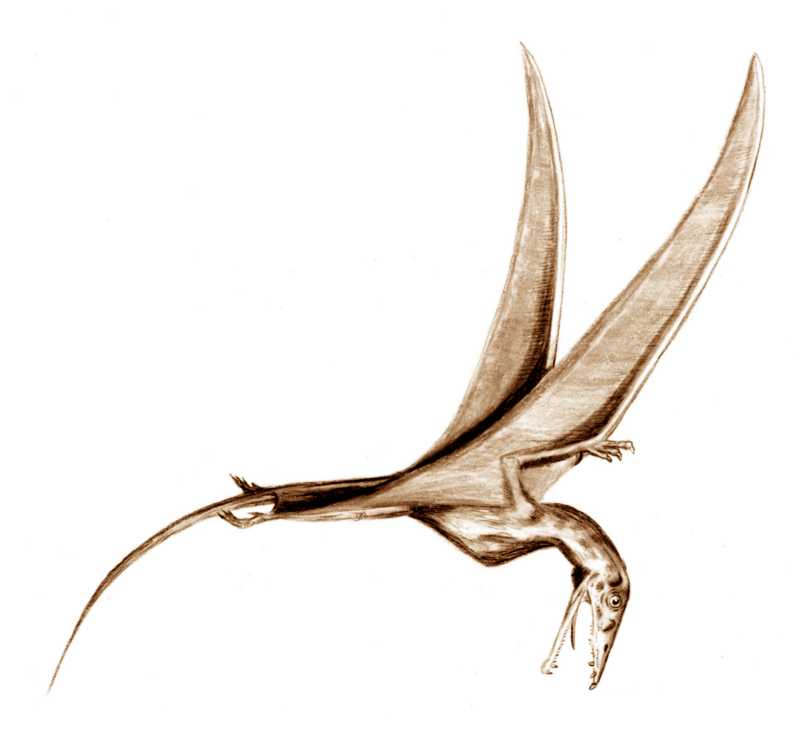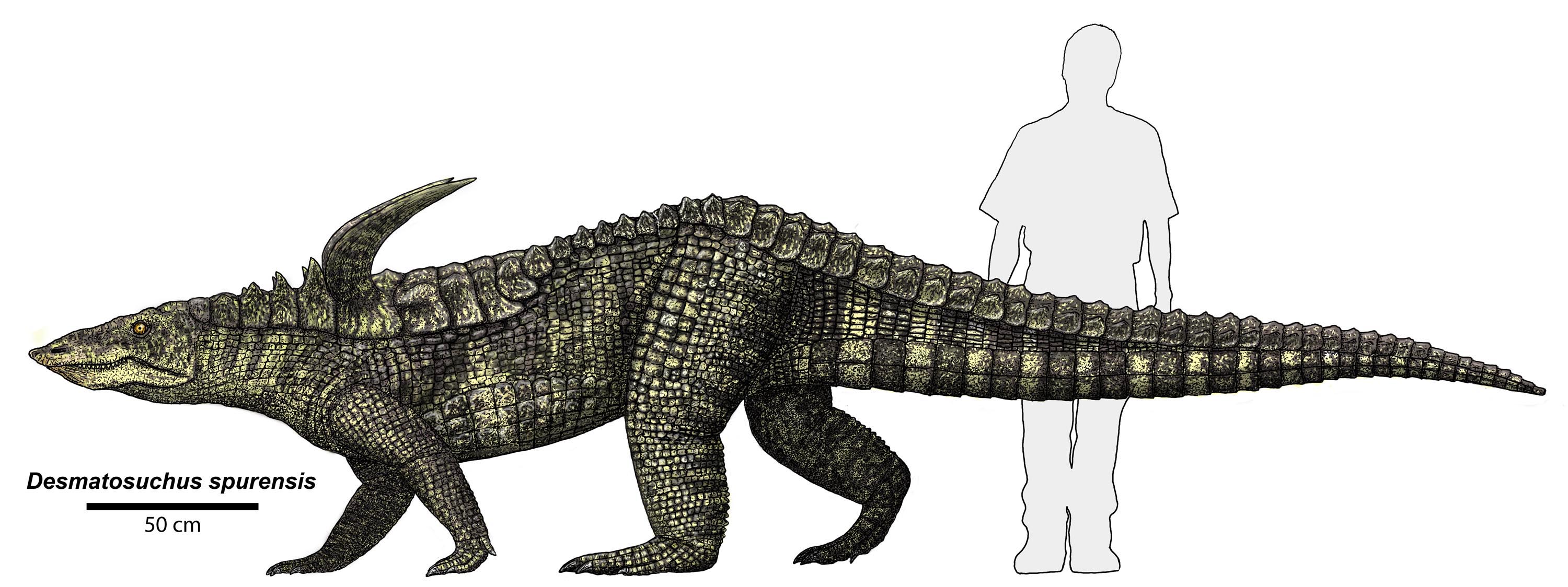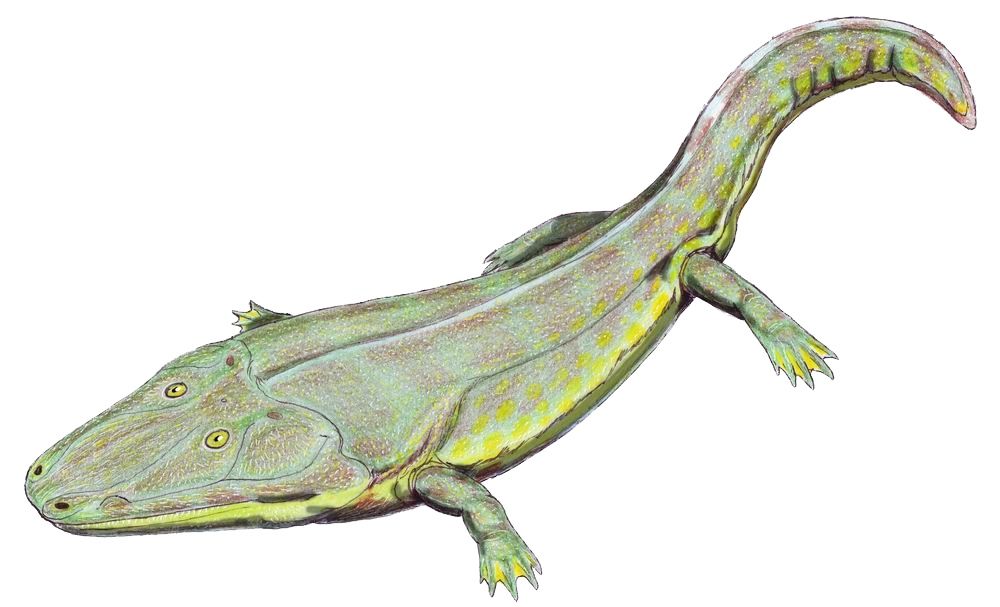|
Aetosaurus
''Aetosaurus'' is an extinct genus of pseudosuchian reptile belonging to the order Aetosauria. It is generally considered to be the most primitive aetosaur. Three species are currently recognized: ''A. ferratus'', the type species from Germany and Italy; ''A. crassicauda'' from Germany; and ''A. arcuatus'' from eastern North America. Additional specimens referred to ''Aetosaurus'' have been found in the Chinle Group of the southwestern United States, and the Fleming Fjord Formation of Greenland. Specimens of ''Aetosaurus'' occur in Norian-age strata. Description ''Aetosaurus'' was a small, primitive aetosaur. Unlike more derived aetosaurs such as ''Desmatosuchus'' or '' Typothorax'', the carapace was long and narrow and lacked spikes. The paramedian scutes that covered the back (with one row on each side of the vertebrae) are considerably wider than they are long. The lateral scutes, which are beneath the paramedians and formed a row on either side of the animal, do not bear a ... [...More Info...] [...Related Items...] OR: [Wikipedia] [Google] [Baidu] |
Aetosauria
Aetosaurs () are heavily armored reptiles belonging to the extinct order Aetosauria (; from Greek, (aetos, "eagle") and (, "lizard")). They were medium- to large-sized omnivorous or herbivorous pseudosuchians, part of the branch of archosaurs more closely related to crocodilians than to birds and other dinosaurs. All known aetosaurs are restricted to the Late Triassic, and in some strata from this time they are among the most abundant fossil vertebrates. They have small heads, upturned snouts, erect limbs, and a body ornamented with four rows of plate-like osteoderms (bony scutes). Aetosaur fossil remains are known from Europe, North and South America, parts of Africa, and India. Since their armoured plates are often preserved and are abundant in certain localities, aetosaurs serve as important Late Triassic tetrapod index fossils. Many aetosaurs had wide geographic ranges, but their stratigraphic ranges were relatively short. Therefore, the presence of particular aetosaurs can ... [...More Info...] [...Related Items...] OR: [Wikipedia] [Google] [Baidu] |
Aetosaurus
''Aetosaurus'' is an extinct genus of pseudosuchian reptile belonging to the order Aetosauria. It is generally considered to be the most primitive aetosaur. Three species are currently recognized: ''A. ferratus'', the type species from Germany and Italy; ''A. crassicauda'' from Germany; and ''A. arcuatus'' from eastern North America. Additional specimens referred to ''Aetosaurus'' have been found in the Chinle Group of the southwestern United States, and the Fleming Fjord Formation of Greenland. Specimens of ''Aetosaurus'' occur in Norian-age strata. Description ''Aetosaurus'' was a small, primitive aetosaur. Unlike more derived aetosaurs such as ''Desmatosuchus'' or '' Typothorax'', the carapace was long and narrow and lacked spikes. The paramedian scutes that covered the back (with one row on each side of the vertebrae) are considerably wider than they are long. The lateral scutes, which are beneath the paramedians and formed a row on either side of the animal, do not bear a ... [...More Info...] [...Related Items...] OR: [Wikipedia] [Google] [Baidu] |
Aetosaurus Ferratus Skull
''Aetosaurus'' is an extinct genus of pseudosuchian reptile belonging to the order Aetosauria. It is generally considered to be the most primitive aetosaur. Three species are currently recognized: ''A. ferratus'', the type species from Germany and Italy; ''A. crassicauda'' from Germany; and ''A. arcuatus'' from eastern North America. Additional specimens referred to ''Aetosaurus'' have been found in the Chinle Group of the southwestern United States, and the Fleming Fjord Formation of Greenland. Specimens of ''Aetosaurus'' occur in Norian-age strata. Description ''Aetosaurus'' was a small, primitive aetosaur. Unlike more derived aetosaurs such as ''Desmatosuchus'' or ''Typothorax'', the carapace was long and narrow and lacked spikes. The paramedian scutes that covered the back (with one row on each side of the vertebrae) are considerably wider than they are long. The lateral scutes, which are beneath the paramedians and formed a row on either side of the animal, do not bear any ... [...More Info...] [...Related Items...] OR: [Wikipedia] [Google] [Baidu] |
Zorzino Limestone
The Calcare di Zorzino, Italian for Zorzino Limestone is a Late Triassic (Norian) geological formation in Italy (Cene and ).Zorzino Limestone at .org and Tanystropheids have been recovered in this formation. Vertebrate paleofauna Other reptiles * '' Aetos ...[...More Info...] [...Related Items...] OR: [Wikipedia] [Google] [Baidu] |
Typothorax
''Typothorax'' is an extinct genus of typothoracine aetosaur that lived in the Late Triassic. Its remains have been found in North America. Two species are known: ''T. coccinarum'', the type species, and ''T. antiquum''. Description ''Typothorax'' was an aetosaur, a pseudosuchian distantly related to modern crocodilians. Unlike modern crocodilians, aetosaurs were herbivorous. ''Typothorax'' and other aetosaurs possess small, leaf-shaped teeth that were unsuited for a diet consisting of meat.Martz, J.W. 2002. The morphology and ontogeny of Typothorax coccinarum (Archosauria, Stagonolepididae) from the Upper Triassic of the American southwest. M.S. thesis, Geosciences, Texas Tech University, Lubbock, 279 pp. Unlike some aetosaurs such as ''Desmatosuchus'', ''Typothorax'' does not have large shoulder spikes. It does, however, have a pair of enlarged spikes on the neck projecting from the third row of scutes. It has lateral scutes that bear horns that are posteriorly hooked along it ... [...More Info...] [...Related Items...] OR: [Wikipedia] [Google] [Baidu] |
Desmatosuchus
''Desmatosuchus'' (, from Greek δεσμός ''desmos'' 'link' + σοῦχος ''soûkhos'' 'crocodile') is an extinct genus of archosaur belonging to the Order Aetosauria. It lived during the Late Triassic. Description ''Desmatosuchus'' was a large quadrupedal reptile upwards of to in lengthvon Baczko, M. B., Desojo, J. B., Gower, D. J., Ridgely, R., Bona, P., & Witmer, L. M. (2021)New digital braincase endocasts of two species of Desmatosuchus and neurocranial diversity within Aetosauria (Archosauria: Pseudosuchia) The Anatomical Record, 1–20. https://doi.org/10.1002/ar.24798 and in weight. Its vertebral column had amphicoelus centra and 3 sacral vertebrae. This archosaur's most distinguishing anatomical characteristics were its scapulae which possessed large acromion processes commonly referred to as "shoulder spikes". The forelimbs were much shorter than the hindlimbs, with humeri less than two-thirds the length of the femurs. The pelvic girdle consisted of a long pub ... [...More Info...] [...Related Items...] OR: [Wikipedia] [Google] [Baidu] |
Fleming Fjord Formation
The Fleming Fjord Formation, alternatively called the Fleming Fjord Group is an Upper Triassic geological formation in the northeastern coast of Jameson Land, Greenland. It consists of terrestrial sediments and is known for its fossil content. Description It is of Norian to Rhaetian age and is subdivided into three members; at the base the Edderfugledal Member, followed by the Malmros Klint Member with the Ørsted Dal Member at the top. It was deposited in a large shallow to ephemeral lake. Paleobiota The fauna of Fleming Fjord is diverse, including sauropodomorph dinosaurs, pterosaurs, temnospondyls, mammaliaforms, aetosaurs, and other taxa. Freshwater unionid bivalves and conchostracans have been reported from the Malmros Klint Member. Fish Lungfish, actinopterygian, and chondrichthyan teeth have been reported from the Malmros Klint Member. Amphibians Reptiles Besides the forms described below, a diverse ichnofauna of small and large tracks has also been reported ... [...More Info...] [...Related Items...] OR: [Wikipedia] [Google] [Baidu] |
Late Triassic
The Late Triassic is the third and final epoch (geology), epoch of the Triassic geologic time scale, Period in the geologic time scale, spanning the time between annum, Ma and Ma (million years ago). It is preceded by the Middle Triassic Epoch and followed by the Early Jurassic Epoch. The corresponding series (stratigraphy), series of rock beds is known as the Upper Triassic. The Late Triassic is divided into the Carnian, Norian and Rhaetian Geologic time scale, Ages. Many of the first dinosaurs evolved during the Late Triassic, including ''Plateosaurus'', ''Coelophysis'', and ''Eoraptor''. The Triassic–Jurassic extinction event began during this epoch and is one of the five major mass extinction events of the Earth. Etymology The Triassic was named in 1834 by Friedrich August von Namoh, Friedrich von Alberti, after a succession of three distinct rock layers (Greek meaning 'triad') that are widespread in southern Germany: the lower Buntsandstein (colourful sandstone'')'', t ... [...More Info...] [...Related Items...] OR: [Wikipedia] [Google] [Baidu] |
Eberhard Fraas
Eberhard Fraas (26 June 1862 – 6 March 1915) was a German scientist, geologist and paleontologist. He worked as a curator at the Stuttgarter Naturaliensammlung and discovered the dinosaurs of the Tendaguru formation in then German East Africa (now Tanzania). The dinosaur ''Efraasia'' is named after him. Life Eberhard Fraas was born in Stuttgart, the son of Oscar Fraas (1824–1897), a curator and professor at the geological and paleontological department of the Württemberg Royal Natural Cabinet. After attending the Gymnasium, he studied at Leipzig University with Hermann Credner and Ferdinand Zirkel, and later in Munich under Karl Alfred von Zittel, August Rothpletz (1853−1918) and Paul Groth. Here, he received his Ph.D in 1886 with a dissertation about Jurassic starfish. His geological work enabled him to publish the first coherent account about the history of the Alps. In July 1888, he received his Habilitation (second Ph.D.) from Munich University, and in 18 ... [...More Info...] [...Related Items...] OR: [Wikipedia] [Google] [Baidu] |
Lower Stubensandtein
{{Disambiguation ...
Lower may refer to: *Lower (surname) *Lower Township, New Jersey *Lower Receiver (firearms) *Lower Wick Gloucestershire, England See also *Nizhny Nizhny (russian: Ни́жний; masculine), Nizhnyaya (; feminine), or Nizhneye (russian: Ни́жнее; neuter), literally meaning "lower", is the name of several Russian localities. It may refer to: * Nizhny Novgorod, a Russian city colloquial ... [...More Info...] [...Related Items...] OR: [Wikipedia] [Google] [Baidu] |
Oscar Fraas
Oscar Friedrich von Fraas (17 January 1824, in Lorch (Württemberg) – 22 November 1897, in Stuttgart) was a German clergyman, paleontologist and geologist. He was the father of geologist Eberhard Fraas (1862–1915). Biography He studied theology at the University of Tübingen (ministry exam, 1845). He was also deeply interested in natural sciences, and while a student at Tübingen was influenced by geologist Friedrich August von Quenstedt. In 1847 he travelled to Paris, where he attended lectures given by Alcide d'Orbigny and Jean-Baptiste Élie de Beaumont. From 1850 to 1854, he served as a pastor in Laufen an der Eyach, [...More Info...] [...Related Items...] OR: [Wikipedia] [Google] [Baidu] |
Paleontologist
Paleontology (), also spelled palaeontology or palæontology, is the scientific study of life that existed prior to, and sometimes including, the start of the Holocene epoch (roughly 11,700 years before present). It includes the study of fossils to classify organisms and study their interactions with each other and their environments (their paleoecology). Paleontological observations have been documented as far back as the 5th century BC. The science became established in the 18th century as a result of Georges Cuvier's work on comparative anatomy, and developed rapidly in the 19th century. The term itself originates from Greek (, "old, ancient"), (, ( gen. ), "being, creature"), and (, "speech, thought, study"). Paleontology lies on the border between biology and geology, but differs from archaeology in that it excludes the study of anatomically modern humans. It now uses techniques drawn from a wide range of sciences, including biochemistry, mathematics, and engineering. ... [...More Info...] [...Related Items...] OR: [Wikipedia] [Google] [Baidu] |









